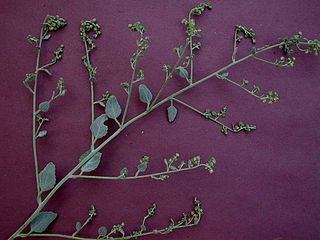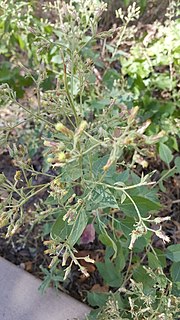
Cirsium arizonicum, the Arizona thistle, is a North American species of thistle in the family Asteraceae, native to the southwestern United States and northwestern Mexico. It has been found in Arizona, southeastern California, New Mexico, Nevada, Colorado, Utah, Sonora, and northwestern Chihuahua.

Dicoria canescens is a North American flowering plant in the family Asteraceae known by several common names including desert twinbugs and bugseed. This is a desert plant of the southwestern United States and northwestern Mexico, found in Sonora, Baja California, southern California, Nevada, Arizona, Utah, southwestern Colorado, and northwestern New Mexico.

Bursera microphylla, known by the common name elephant tree in English or 'torote' in Spanish, is a tree in genus Bursera. It grows into a distinctive sculptural form, with a thickened, water-storing or caudiciform trunk. It is found in the southwestern United States and northwestern Mexico.

Cirsium neomexicanum is a North American species of thistle known by the common names New Mexico thistle, powderpuff thistle, lavender thistle, foss thistle and desert thistle.

Calycoseris wrightii, commonly known as white tackstem, is an annual spring wildflower, one of two species in the genus Calycoseris; the other species is C. parryi, the yellow tackstem. They are part of the family Asteraceae.

Baccharis brachyphylla is a North American species of shrub in the family Asteraceae, known by the common name shortleaf baccharis or false willow. It is native to the southwestern United States and northern Mexico. It grows in desert habitats such as arroyos and canyons.

Baileya pauciradiata is a species of flowering plant in the daisy family which is known by the common names laxflower and Colorado desert marigold. It is native to the deserts of northwestern Mexico and the southwestern United States. It has been found in the States of California, Arizona, Nevada, Baja California, and Sonora.

Rafinesquia neomexicana is a species of flowering plant in the family Asteraceae. Common names include desert chicory, plumeseed, or New Mexico plumeseed. It has white showy flowers, milky sap, and weak, zigzag stems, that may grow up through other shrubs for support. It is an annual plant found in dry climate areas of the southwestern deserts of the US and northwestern deserts of Mexico.

Yucca × schottii is a plant species in the genus Yucca, native to southern Arizona, southwestern New Mexico, and the northern parts of Sonora and Chihuahua. The common names are Schott's yucca, hoary yucca, and mountain yucca. The "×" in the name indicates that this is a nothospecies, regarded as being a natural hybrid between two other species. In this case, Yucca × schottii is believed to have originated as a hybrid between Y. baccata and Y. madrensis. Yucca × schottii is firmly established and does reproduce freely in the wild.

Ambrosia salsola, commonly called cheesebush, winged ragweed, burrobush, white burrobrush, and desert pearl, is a species of perennial shrub in the family Asteraceae native to deserts of the southwestern United States and northwestern Mexico.
Bidens lemmonii is a North American species of flowering plant in the family Asteraceae. It is native to the southwestern United States and Mexico.
Brickellia simplex, the Sonoran brickellbush, is a North American species of flowering plants in the family Asteraceae. It is native to northern Mexico and the southwestern United States.

Brickellia floribunda, the Chihuahuan brickellbush, is a North American species of flowering plants in the family Asteraceae. It is native to northern Mexico and the south-western United States.
Brickellia baccharidea, the resinleaf brickellbush, is a North American species of shrubs in the family Asteraceae. It is native to the southwestern United States and northwestern Mexico.
Coreocarpus arizonicus, the little lemonhead, is a North American species of flowering plants in the daisy family native to northwestern Mexico and the southwestern United States. It has been found in southern Arizona, and in the adjacent Mexican States of Sonora, Chihuahua, Sinaloa, and Baja California Sur.
Erigeron lobatus is a rare species of flowering plant in the family Asteraceae known by the common name lobed fleabane. It has been found the state of Sonora in northwestern Mexico as well as in the southwestern United States.
Erigeron oxyphyllus is a species of flowering plant in the family Asteraceae known by the common name wand fleabane. It is native to northwestern Mexico and the southwestern United States.
Helenium laciniatum is a North American perennial plant in the sunflower family. It is found in the states of Sinaloa and Sonora in northwestern Mexico.
Fleischmannia sonorae, the Sonoran slender-thoroughwort or Sonoran thoroughwort, is a North American species of flowering plant in the family Asteraceae. It is native to western Mexico from Sonora and Chihuahua as far south as Michoacán, as well as from the southwestern United States.

Hymenothrix wrightii is a North American species of flowering plant in the daisy family. It grows in northwestern Mexico and the southwestern United States.











